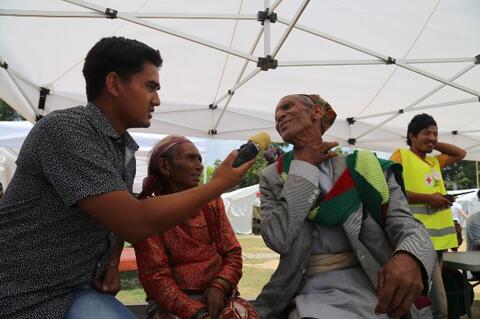Open Mic Nepal

"When people have little reliable information available to them, rumors, myths and misunderstanding spread rapidly, adding greatly to the stress and anxiety of already traumatized people."
Open Mic Nepal is a project that tracks perception and rumours circulating on the ground among earthquake-affected communities. Information is collected from volunteers and partners who work extensively on the ground, verify the information, and present it in weekly reports to support the work of humanitarian agencies and local media. Open Mic Nepal is presented by Internews and #quakehelpdesk and is implemented by Accountability Lab and Local Interventions Group.
The volunteer-driven Open Mic Nepal is a systematic information loop that tracks, investigates, and reports back to local communities on damaging rumours in the aftermath of crises. Volunteers from multiple organisations who are assisting earthquake victims to access aid and services collect and text in the rumours and concerns they hear from local populations as part of their daily routines. (A recent Open Mic bulletin was based on conversations with 450 people in a one-week period.) The Open Mic team then geolocates, analyses, and reports on the most pressing or common concerns. For example, there was a rumour out of Charikot, Dolakha, that the number of women aborting their pregnancies doubled after the earthquake. In fact, as reported in OpenMic Issue #5, the District Public Health Office said this was not the case, although what had risen was the number of pregnant women consulting health workers about their babies' health, which is a highly recommended practice. Related facts were distributed, along with a hotline number for those seeking more information and guidance. In addition to being published online, the bulletins are shared with the on-the-street volunteers themselves, to complete the feedback loop, as well as with the wider humanitarian system.
By keeping the rumors intact in the bulletins, the Open Mic project allows local media and humanitarians not only to debunk the rumours and address the factual misinformation, but also to investigate why certain rumors are so popular. Research shows that rumour mongering can serve a kind of collective problem solving. The analysis of persistent rumors can be very revealing, as many are not malevolent and do contain versions of truth. Tracking them provides information about information eco-systems, mistrust, and information gaps left open by government and humanitarians.
Risk Management.
Internews, #quakehelpdesk, Accountability Lab, and Local Interventions Group.
"Can You Stop a Rumor?", by Alison Campbell, Internews, August 11 2015 - accessed on June 28 2016. Image credit: Madhu Acharya/Internews
- Log in to post comments
